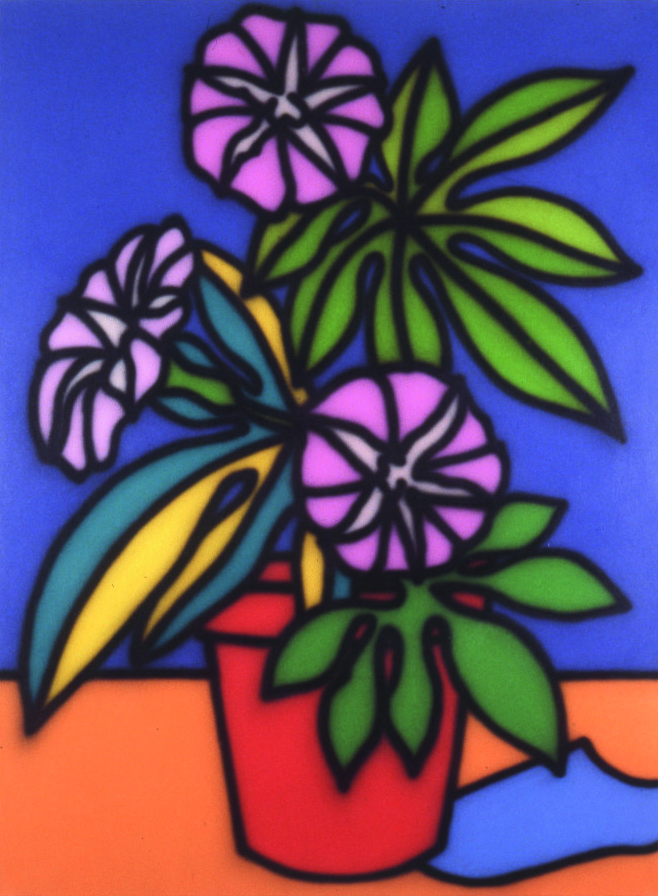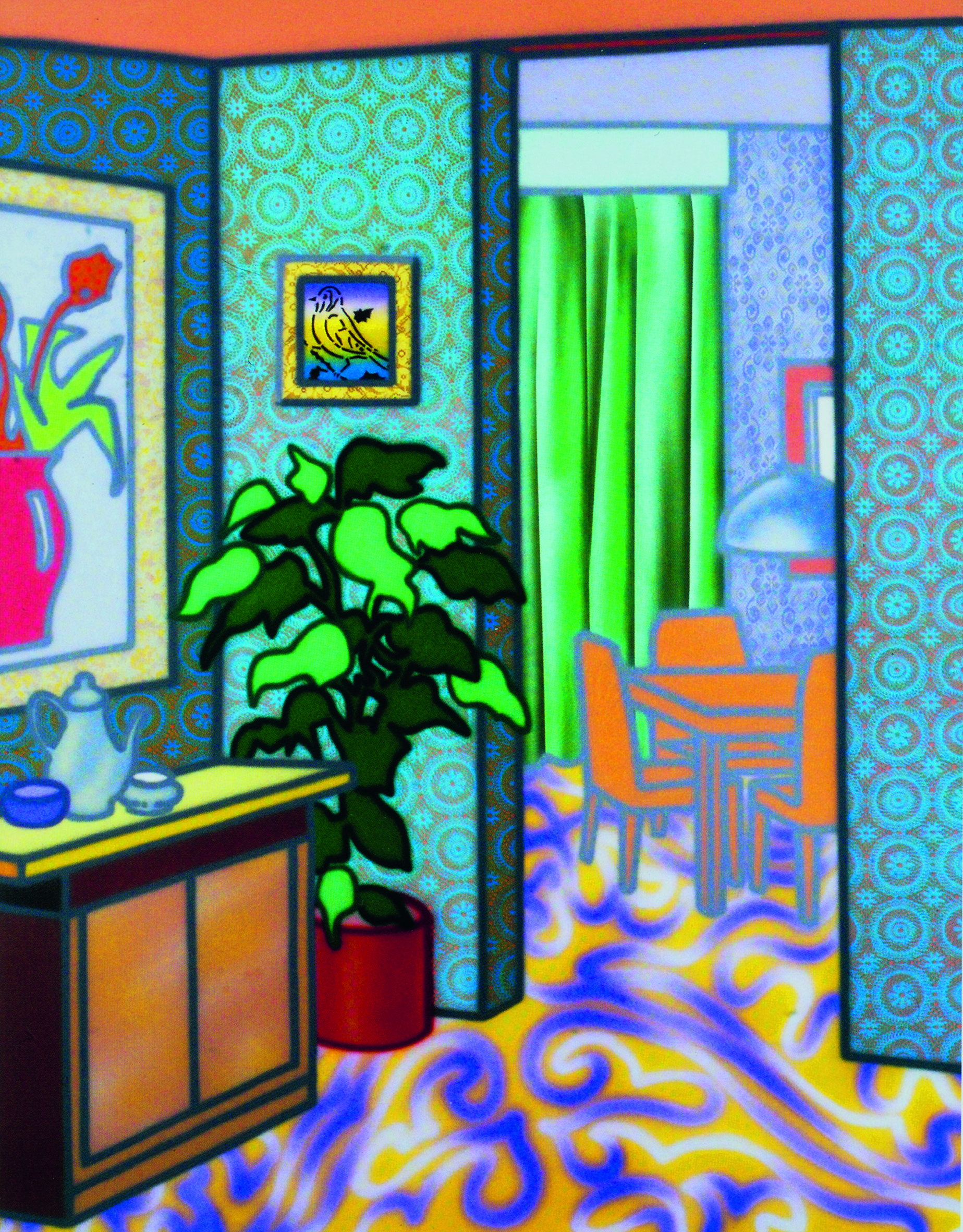TULIPS AND SPOTTED VASE, 1986
HOWARD ARKLEY
synthetic polymer paint on canvas
161.0 x 120.0 cm
signed, dated and inscribed with title verso: Tulips and Spotted Vase / 1986 / Howard Arkley
Tolarno Galleries, Melbourne
Private collection, Melbourne, acquired from the above in 1986
Tolarno Galleries, Melbourne
Private collection, Melbourne, acquired from the above in May 1995
Howard Arkley: Recent Paintings, Tolarno Galleries, Melbourne, 20 September – 8 October 1986, cat. 6
Downtown: Ruscha, Rooney, Arkley, Museum of Modern Art at Heide, Melbourne, 14 March – 14 May 1995
Engberg, J., Downtown: Ruscha, Rooney, Arkley, Museum of Modern Art at Heide, Melbourne, 1995, pp. 51 (illus.), 58
Crawford, A., and Edgar, R., Spray: The Work of Howard Arkley, Craftsman House, Sydney, revised edition, 2001, pp. 83 (illus.), 148 (dated '1987')
Howard Arkley Online Catalogue Raisonné: [https://www.arkleyworks.com/blog/2009/11/18/tulips-and-spotted-vase-1986/] (accessed 10 October 2024)
hero-1440 cmyk copy.jpg

After producing few canvases in 1984 and 1985 – instead working primarily on paper, and in his sketchbooks and diaries – Howard Arkley returned to painting with gusto in 1986.1 His solo exhibition of that year, Howard Arkley: Recent Paintings at Melbourne’s Tolarno Galleries, was an exuberant demonstration of the artist in form, showcasing a strong sampling of characteristic Arkley subjects ranging from suburban houses, skyscrapers and interiors to the artist’s funky, cacti-inspired abstractions. However, the lively compositions and high-keyed colour of most of the works in the exhibition were also tempered by the subject matter and mood of paintings such as The Ritual, 1986 – which depicted a figure about to insert a needle into an extended, tourniqueted arm – Speeding, 1986, and Nubrick, 1986, the latter of which conveyed a darker, slightly sinister atmosphere, despite its setting in a suburban street. As one of only two still life paintings within the exhibition, and the most commanding, Tulips and Spotted Vase, 1986 sat thematically between these two extremes, marrying the joy and exuberance of the artist’s use of decoration and strong blocks of colour with the work’s subject matter and nod to the vanitas tradition. No doubt aware of the rich symbolism of still life painting in art history, Arkley’s placement of the open, drooping tulip in the foreground of the image serves as a subtle reminder to the viewer of the transience of both beauty and life. Sadly, given the artist’s premature death from a drug overdose at the age of 48, it is hard not to see the quiet message within this buoyant painting as somewhat prophetic.
Given Arkley’s well-known love of decoration and ornamentation, Tulips and Spotted Vase is a relatively restrained painting, with the vase itself the only ‘decorated’ part of the composition. However, together the vase and flowers form the kind of decoration that was readily accepted in the interiors of the suburban houses that were to increasingly feature in his paintings from this time. Arkley painted his first house painting in 1983 and remained enchanted by this symbol of the suburban dream until his death in 1999. Having grown up in the Melbourne suburb of Surrey Hills, he realised he was speaking to the lived experience of most Australians, and that the classic ‘brick veneer on a quarter-acre block’ provided him with the creative potential to endlessly combine and experiment with both pattern and form, figuration and abstraction. As he enthused in an interview for ABC TV in 1999:
Howard Arkley-Roomarama cmyk copy.jpg

‘Ordinary houses are filled with pattern. You go into a house where there is no art, no paintings, but it is filled with kind of second-degree imagery. The patterning around the fireplace, the carpet, and the different brick on the different houses, and the pattern between the gutter, the nature strip, the footpath; then you have the fence, then you have the green lawn, then you have house, then you have the tiles, then you have the blue sky… and I missed the bushes in between. It’s rich.’2
Arkley’s work has been compared to American and British Pop artists Roy Lichtenstein (1923 – 1997) and Patrick Caulfield (1936 – 2005), whose practice shared a penchant for areas of bold flat colour and the depiction of everyday utilitarian objects such as vases, bowls and jugs. While he undoubtedly knew and drew inspiration from their art, Arkley’s oeuvre however, is clearly differentiated by its love and use of pattern – which he initially created by incorporating wallpaper into his interiors3, and later, through the use of stencils – and especially, by his use and command of the airbrush. Arkley was first introduced to the airbrush by his art schoolteacher, Fred Cress, and by the time Tulips and Spotted Vase was created, it was clearly in his command (each line required several coats to ensure both the thickness and dense pigmentation that the artist achieves).4 For him, the combination of black outline and flat surface helped to establish a sense of his images as being at one in both the making (‘… I thought it was a pretty interesting kind of medium – that you could make marks without actually touching the canvas’5), and viewing; as if his paintings were experienced in reproduction rather than real life. As he noted:
‘I wanted my work to look like a reproduction of a painting, not be a painting. I want it to look like it was a slide or a book. I want it to look like the paintings that educated me, and I saw them in reproduction in books and magazines and slides etc. I didn’t want any great big globules of paint running down, because in a book they don’t have that – they’re nice and flat and shiny.’6
1. Gregory, J., Arkley Works, see: https://www.arkleyworks.com/blog/2009/11/18/1986/ (accessed 24 October 2024)
2. Wyzenbeek, A. (dir.), Howard’s Way, 1999, ABC TV Arts, see excerpt at https://www.youtube.com/watch?v=YByGawnhx7E (accessed 24 October 2024)
3. See Howard Arkley, Still Life, 1986 that was also in the 1986 Tolarno Galleries at https://www.arkleyworks.com/blog/2009/11/18/1986/ (accessed 24 October) and Howard Arkley, Suburban Interior, 1983, Heide Museum of Modern Art, Melbourne at https://collection.heide.com.au/objects/719/suburban-interior (accessed 25 October 2024)
4. ‘Constanze Zikos, Artist and Friend of Howard Arkley Speaking to Howard Arkley and Friends Exhibition Co-Curator Victoria Lynn’, TarraWarra Museum of Art, 6 February 2016, see: https://www.facebook.com/TarraWarraMA/videos/constanze-zikos-artist-and-... (accessed 24 October 2024)
5. Howard Arkley, cited in Wyzenbeek, op. cit.
6. ibid.
KELLY GELLATLY

